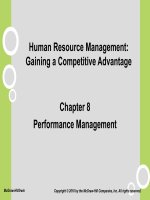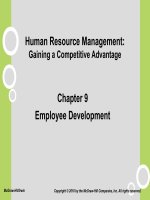HRM gaining a competitive advantage noe ch011
Bạn đang xem bản rút gọn của tài liệu. Xem và tải ngay bản đầy đủ của tài liệu tại đây (255.87 KB, 29 trang )
Human Resource Management:
Gaining a Competitive Advantage
Chapter 11
Pay Structure Decisions
McGraw-Hill/Irwin
Copyright © 2010 by the McGraw-Hill Companies, Inc. All rights reserved.
Learning Objectives
List major decision areas and concepts in employee
compensation management.
Describe major administrative tools used to manage
employee compensation.
Explain the importance of competitive
labor-market and product-market forces in compensation
decisions.
Discuss the significance of process issues such as
communication in compensation management.
11-2
Learning Objectives
Describe new developments in pay structure designs.
Explain where U. S. stands on pay issues from an
international perspective.
Explain reasons for executive pay controversy.
Describe the regulatory framework for employee
compensation.
11-3
Introduction
Employer’s View:
Employee’s View:
• Pay is critical in
attaining strategic
goals.
• Pay impacts employee
attitudes and behaviors.
• Employee
compensation is
significant
organizational cost.
• Policies having to do with
wages, salaries, and
other earnings affect their
overall income and thus
their standard of living.
• Both level of pay and
fairness compared with
others’ pay are important.
11-4
Developing Pay Levels
Pay structure - relative pay of different jobs
(job structure) and how much they are paid (pay level).
Pay level - average pay, including wages, salaries and
bonuses.
Job structure - relative pay of jobs (the range of pay often
expressed by salary grades).
Pay policiesare attached to jobs, not individuals.
11-5
Equity Theory and Fairness
Pay Structure Concepts and Consequences
Pay Structure
Decision Area
Administrative
Tool
Focus of
Employee Pay
Comparisons
Pay Level
Market pay surveys External equity
Job Structure
Job evaluation
Internal equity
Consequences of
Equity Perceptions
External employee
movement, labor
costs, employee
attitudes
Internal employee
movement,
cooperation,
employee attitudes
11-6
Developing Pay Levels –
Market Pressures
2 Competitive Market Challenges in Pay Decisions:
1. Product-market competition –challenge to sell
goods and services at a quantity and price thatwill
bring a return on investment.
2. Labor-market competition –amount an organization
must pay to compete against other organizations that
hire similar employees.
11-7
Employees as a Resource
A philosophy that considers employees to be an
investment that will yield valuable returns.
Controlling costs through noncompetitive pay can result in
low employee productivity and quality.
Pay policies and programs are one of the most important
HR tools for encouraging desired employee behaviors and
discouraging undesired behaviors.
11-8
Deciding What to Pay
Deciding pay levels is discretionary and is based on a broad
range.
The organization has to decide whether to pay at, below, or
above the market average.
Efficiency wage theory- wages influence worker productivity.
11-9
Market Pay Surveys
Benchmarking is a procedure by which an organization
compares its own practices against
the competition.
3 issues to determine before using pay surveys :
1. Which employers should be included in the survey?
2. Which jobs are included in the survey?
3. If multiple surveys are used, how are all the rates of
pay weighted and combined?
11-10
Product MarketV. Labor Market
Comparisons
Product-market
comparisons will
be more important
when:
• Labor costs
represent a large
share of total costs.
• Product demand is
elastic.
• The supply of labor
is inelastic.
• Employee skills are
specific to the
product market.
Labor-market
comparisons will
be more important
when:
• Attracting and
retaining employees
is difficult.
• The costs of
recruiting are high.
11-11
Rate Ranges, Key and Non-key Jobs
Rate ranges- different employees in the same job that may
have different pay rates.
Key jobs are benchmark jobs that have relatively stable
content and are common to many organizations so that
market-pay survey data can be obtained.
Non-key jobs are unique to organizations and cannot be
directly valued or compared through the use of market
surveys.
11-12
Developing a Job Structure
Job structure- relative worth of various jobs in the
organization, based on internal comparisons.
Job evaluation is an administrative procedure used to
measure internal job worth.
The evaluation process is composed of
compensable factors, which are the characteristics
of jobs that an organization values and chooses to
pay for.
Job evaluators often apply a weighting scheme to
account for the differing importance of compensable
factors to the organization.
11-13
Developing a Pay Structure
3 Pay-setting Approaches:
1. Market Survey Approach - The greatest emphasis is
on external comparisons. It bases pay on market
surveys that cover as many key jobs as possible.
2. Pay Policy Line - A mathematical expression that
describes the relationship between a job’s pay and its
job evaluation points.
3. Pay Grades- Grouping jobs of similar worth or content
together for pay administration purposes.
Range spread is the distance between minimum and
maximum amounts in a pay grade.
11-14
Conflicts –
Market Pay Surveys & Job Evaluation
Internal data would drive up labor costs and create productmarket problems.
If external market data are emphasized and a job
is paid lower internally, comparisons that employees make
internally would result in dissatisfaction.
An organization should consider its strategy, what
jobs and/or functions will be critical for success and marketcompetitive pressures.
11-15
Monitoring Compensation Costs
One way to examine the difference between policy
and practice is to compute a compa-ratio,
which is an index of the correspondence between
actual and intended pay.
11-16
Globalization, Geographic Region
and Pay Structure
Pay structuresdiffer across countries
in level and relative worth of jobs.
Although expatriate pay and benefits
have been linked more closely to the home
country, this link now appears to depend
more on the assignment’s nature and
length.
11-17
The Importance of Process:
Participation and Communication
Participation
Participation should
involve those who will
manage and be affected
by the process.
Participation includes
recommending,
designing and
communicating a pay
program.
Typically, pay-level
decisions are only made
by top management.
Communication
The effect of
communication is likely to
impact employees'
perceptions of equity.
Managers must be
prepared to explain why
the pay structure is
designed the way it is
and to judge whether
changes should be made
to the structure.
11-18
Current Challenges
Job-based pay structures can create problems:
reinforces top-down decision making as well as
status differentials.
bureaucracy, time and cost required to generate and
update job descriptions can become a barrier to
change.
job-based structure may not reward desired
behaviors, where the knowledge, skills, and abilities
needed yesterday may not be helpful today and
tomorrow.
system encourages promotion-seeking behavior, but
discourages lateral movement.
11-19
Current Challenges
3 Responses to Problems with Job-based Pay Structures:
1. delayer – reducing number of job levels within an
organization to provide more flexibility in job
assignments and in assigning merit increases.
2. moving away from linking pay to jobs toward building
structures on skill, knowledge and competency.
3. Skill-based pay - paying individuals for skills they are
capable of using rather than for the job they are
performing.
11-20
Can the U.S. Labor Force Compete?
U. S. labor cost are high compared to newly industrialized and
developing countries.
4 Factors Shifting Production to Other Countries:
Stability
Non-labor
considerations
Productivity
Unit Labor Costs
&G.D.P.
Skill levels
quality &
productivity
11-21
Executive Pay
Executive pay has been given widespread attention in
the press.
Executive pay accounts for a small proportion of
labor costs.
Executives have a disproportionate ability to
influence organizational performance.
Executives help set culture, so if their pay seems
unrelated to organizational performance,
employees may not understand why their pay
should be at risk depending on the organization's
performance.
11-22
CEO Remuneration in U.S. Dollars
11-23
Reasons for Executive Pay Criticisms
Some executives are very highly paid.
U.S. executives - best paid in the world.
Ratio of executive pay to average
worker pay creates a "trust gap" workers do not trust executives'
intentions and resent their pay.
11-24
Equal Employment Opportunity
(EEO) regulations prohibitssex and race-based differences
in employment outcomes such as pay, unless justified by
business necessity.
Organizations must also deal with changing labor market
and demographic realities.
2 Trends Related to EEO:
1. increasing participation of women and nonwhites in
the labor force.
2. proportion of wages in 2006 that women earn
compared to men was 81 % and black to white
earnings was 80 %.
11-25









